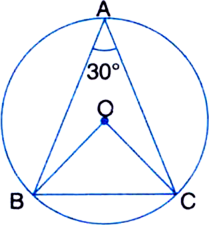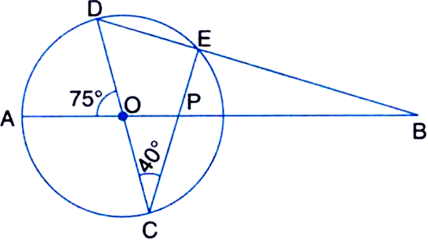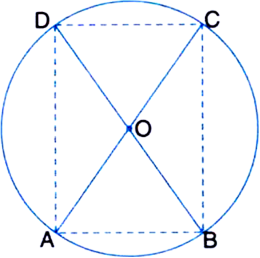 Short Answer Type
Short Answer TypeIn the figure below, ABC is a triangle in which ∠BAC = 30°. Show that BC is equal to radius of the circumcircle where centre is O.

 Long Answer Type
Long Answer TypeTwo chords AB and CD of lengths 5 cm and 11 cm respectively of a circle are parallel to each other and are on opposite sides of its centre. If the distance between AB and CD is 6 cm, find the radius of the circle.
The lengths of two parallel chords of a circle are 6 cm and 8 cm. If the smaller chord is at distance 4 cm from the centre, what is the distance of the other chord from the centre?
Let the vertex of an angle ABC be located outside a circle and let the sides of the angle intersect equal chords AD and CE with the circle. Prove that ∠ABC is equal to half the difference of the angles subtended by the chords AC and DE at the centre.
 Short Answer Type
Short Answer Type Long Answer Type
Long Answer TypeAC and BD are chords of a circle which bisect each other. Prove that (i) AC and BD are diameters, (ii) ABCD is a rectangle.
Given: AC and BD are chords of a circle that bisect each other.
To Prove: (i) AC and BD are diameters
(ii) ABCD is a rectangle.
Construction: Join AB, BC, CD and DA.
Proof: (i) ∵ ∠A = 90°
∴ BD is a diameter
| ∵ Angle in a semi-circle is 90°
∵ ∠D = 90°
∴ AC is a diameter
| ∵ Angle in a semi-circle is 90°
Thus, AC and BD are diameters.
(ii) Let the chords AC and BD intersect each other at O. Join AB, BC, CD and DA.
In ∆OAB and ∆OCD,
OA = OC | Given
OB = OD | Given
∠AOB = ∠COD | Vert. opp. ∠s
∴ ∆OAB ≅ ∆OCD | SAS
∴ AB = CD | C.P.C.T.![]()
Similarly, we can show that
![]()
Adding (1) and (2), we get![]()
⇒ BD divides the circle into two equal parts (each a semi-circle) and the angle of a semi-circle is 90°.
∴ ∠A = 90° and ∠C = 90°
Similarly, we can show that
∠B = 90° and ∠D = 90°
∴ ∠A = ∠B = ∠C = ∠D = 90°
⇒ ABCD is a rectangle.
